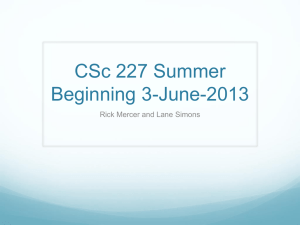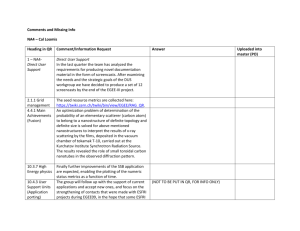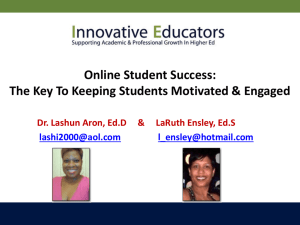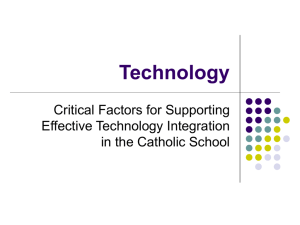Powerpoint Slides
advertisement
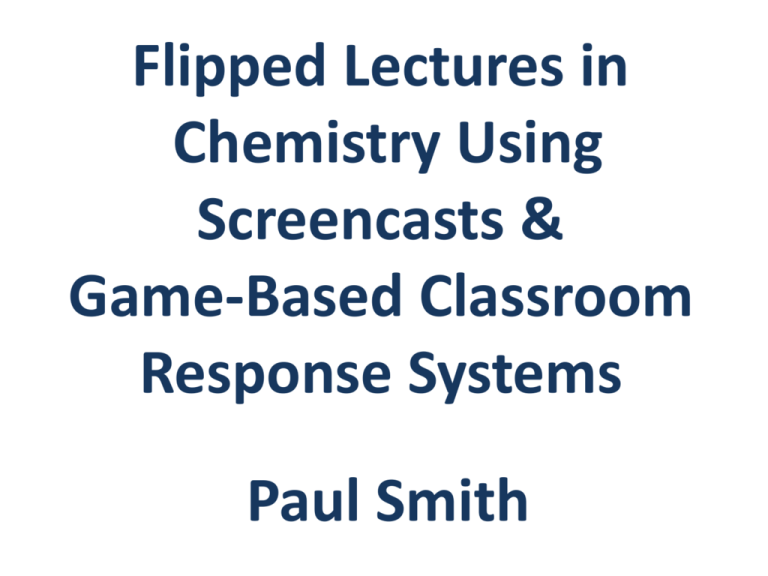
Flipped Lectures in Chemistry Using Screencasts & Game-Based Classroom Response Systems Paul Smith 1.The mode of teaching has not changed much. 2. The way people learn has changed. 3. The skills required for the workplace have changed. What happens in a lecture? “Some people talk in their sleep. Lecturers talk while other people are sleeping.” Albert Camus “Lecturing is that mysterious process by means of which the contents of the note-book of the professor are transferred through the instrument of the fountain pen to the note-book of the student without passing through the mind of either.” Creative Learning and Teaching by Harry Lloyd Miller (1927) Transfer of information. 1.Teach as we were taught. 2. Too much on what to teach and not emphasis enough on how to teach. 3. Death by PowerPoint. Poh, M. Z., Swenson, N. C. and Picard, R. W. (2010). A wearable sensor for unobtrusive, long-term assessment of electrodermal activity, IEEE Transactions on Biomedical Engineering 57, 1243–1252. Poh, M. Z., Swenson, N. C. and Picard, R. W. (2010). A wearable sensor for unobtrusive, long-term assessment of electrodermal activity, IEEE Transactions on Biomedical Engineering 57, 1243–1252. Poh, M. Z., Swenson, N. C. and Picard, R. W. (2010). A wearable sensor for unobtrusive, long-term assessment of electrodermal activity, IEEE Transactions on Biomedical Engineering 57, 1243–1252. Poh, M. Z., Swenson, N. C. and Picard, R. W. (2010). A wearable sensor for unobtrusive, long-term assessment of electrodermal activity, IEEE Transactions on Biomedical Engineering 57, 1243–1252. What is a Flipped Classroom? http://blog.peerinstruction.net/ 1.Transfer of information (in class) 2. Assimilation of that information (out of class) 1.Transfer of information (in class) 2. Assimilation of that information (out of class) 1.Transfer of information (out of class) 2. Assimilation of that information (in class) 1.Transfer of information (out of class) Pre-Lecture Screencasts 2. Assimilation of that information (in class) Kahoot Quizzes Level 6 core unit Advanced Chemical Concepts 1 Division of Chemistry and Environmental Science 100 students (61 male and 39 female) Significant theory component bridging between inorganic and organic chemistry. The class met once a week for a 60 min lectures and once a fortnight for a 60 min tutorial. Lecture/Lab /Tutorial supplement Model Answers Use of online resources Whole Lectures A screencast is a recording of the computer screen that can include narration and synchronous visible author activity such as mouse movements, annotations, editing and operational tasks. Open Day Talks Short Videos on Key Topics Feedback (individual or cohort) Worked examples SCREENCASTS: WHY? Using pre-lecture screencasts can prime students for classes. Release contact time for more interactive learning activities using the flipped teaching model. As independent study aid for particularly challenging material. Effective means of showing ‘how to’. Used as revision tools. Screencasts offer a versatile teaching tool that can capture the spoken word of the teacher for later use by the students. EXAMPLES OF ‘HOW TO’ SCREENCAST PowerPoint BB Flashback Pro 3 Recorder http://www.elearning.mmu.ac.uk/ http://michaelseery.com/home/wp-content/uploads/2010/12/ Screencasting-and-podcasting-for-supporting-lectures.pdf Camtasia Studio http://www.techsmith.com/tutorial-camtasia.html https://mmutube.mmu.ac.uk/search/searchkeyword/PaulSmith SCREENCASTS: TIPS Have a plan/script with clear sections. Avoid reference to specific modules, dates, etc. which can impact on the shelf-life/versatility and may require timeconsuming editing or having to re-record. Try not to talk too quickly. For audio, the recording environment has to be quiet. Talking into a microphone can feel strange at first, but the more you do it, the easier it becomes, sometimes standing while recording can feel more natural. Listening back to yourself can be a painful exercise, but it is important to do this so you can improve quality of future screencasts. Keep it short, develop a screencast for 1 key concept or learning outcome, 5 min is suitable for most purposes, with a limit of 10 min in special cases. SCREENCASTS: PROS They can be viewed again and again allowing students to study at their own pace and to digest complex and detailed topics. Students who have to miss a lecture for very valid reasons, the screencasts allow them to catch up on the material missed. They are helpful for students with PLPs since they can listen/view the explanations for the material rather than read through a series of note that may use complicated language. Students who find a large, sometimes noisy lecture theatre distracting and not conducive to concentration can view the material in a more suitable environment. They can generally be accessed from anywhere with an internet connection and give students the ability to be able to view a lecture in their own time and space. Some students find that they concentrate better at different times of the day and hence value the opportunity to be able to listen to a lecture at any particular time. Pre-lecture screencasts provide a good mechanism to introduce the flipped teaching approach in to your classes. Pre-lecture screencasts provide a good opportunity for staff to prepare for the class. Pre-lecture screencasts help to integrate the VLE in to the weekly routine of timetabled classes. They can be helpful to students for whom English is not their first language. SCREENCASTS: CONS Time-consuming to plan and prepare Shelf-life Managing student expectations Effect on attendance STUDENT FEEDBACK: STUDENT COMMENTS: “Excellent learning tool as students can learn material on the move by viewing whilst on the train going to uni.” “Easily accessible and allows questions to be raised in lectures.” “I believe that an introduction is vital and helps students develop a deeper understanding of the topic.” “Screencasts are much better than just reading notes on their own and they are very useful for understanding some of the more complex material”. “They proved to be very concise and really helped with revision, making it easier to get to the point.” “I can’t think of a single reason why not to do it.” “This is pushing forward the way we learn and keeping with the times.” “Screencasts provide core basis of understanding which are built on in lectures/tutorials/study time.” “Very good for factual heavy units”. “I wish other lecturers would provide them.” The Socratic Method “Teaching by questioning NOT by telling.” In practise the Socratic method of education requires teachers to engage students by asking questions that require generative answers. Ideally, the answers to questions are not a stopping point for thought but are instead a beginning to further analysis and research. http://www.learnnc.org/lp/pages/4994 Audience participation was improved by using smartphones combined with a game-based learning and classroom response system. Kahoot (see https://getkahoot.com/) Three short quizzes each containing up to five questions were prepared for each lecture. Peer Instruction Formative Feedback STUDENT COMMENTS: “The quizzes help to maintain interest in the lecture and promote interaction to help make the lecture more interesting.” “They allow you to apply the material to something which makes it easier to grasp.” “They refresh your memory of recent content and help to put theories into practise.” “Gives an idea of example questions and allows you to reaffirm your understanding of the topics.” “The interactive quizzes give a chance to actually understand what is being taught in the lecture.” “I don’t like to discuss why I answered a certain way, don’t want to appear stupid if I’ve got the wrong answer.” CONCLUSIONS: They are not an easy option for both staff and students. The development of the resources is time-consuming, which can feel like a bold commitment. This model does not involve any reduction in contact hours but the primary focus is on how this time is used. I plan to continue to introduce more screencasts/flipped classes into my teaching, but at present, I am not in the position to completely phase out lectures. Ultimately, student reaction has been very positive and I enjoy teaching this way. When the plate is uniformly heated the diameter of the hole 1. Increases. 2. Stays the same. 3. Decreases. 4. Not possible to tell.
